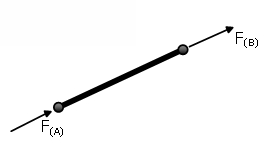Inelastic truss element - truss
The inelastic truss element might come particularly handy in those cases where there is a need to introduce members that work in their axial direction only (e.g. horizontal or vertical braces, steel trusses, etc). In order to fully characterise this type of element class users need only to select a cross-section and specify the number of fibres in which the latter is to be subdivided. The stiffness matrix of this element is made up of a single term EA, updated at every step of the analysis.
In this element's dialog box it is also possible to define an element-specific damping, as opposed to the global damping described in here. To do so, users need simply to press the Damping button and then select the type of damping that better suits the element in question (users should refer to the Damping menu for a discussion on the different types of damping available and hints on which might the better options). Users are reminded also that damping defined at element level takes precedence over global damping, that is, the "globally-computed" damping matrix coefficients that are associated to the degrees-of-freedom of a given element will be replaced by coefficients that will have been calculated through the multiplication of the mass matrix of the element by a mass-proportional parameter, or through the multiplication of the element stiffness matrix by a stiffness-proportional parameter, or through the calculation of an element damping Rayleigh matrix.
Notes
- Given that no flexure will be present in the element, a much reduced number of fibres, with respect to the case of infrm elements, needs to be employed in order to warrant accurate results.
- Modelling a rigid floor diaphragm using pinned crossed struts may give rise to unrealistically high axial forces in floor beams. In order to avoid this, one may think of introducing a coincident elfrm element featuring infinite axial stiffness and connected to link elements that would only transmit axial load. In this way, the very rigid element would absorb the axial load, whilst the rotations (hence moments) would be transmitted to the original beam elements.
- If Rayleigh damping is defined at element level, using varied coefficients from one element to the other, or with respect to those employed in the global damping settings, then non-classical Rayleigh damping is being modelled, classing Rayleigh damping requires uniform damping definition.
Local Axes and Output Notation

